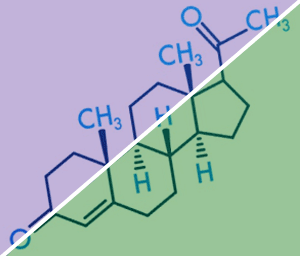The Difference Between Bioidentical Progesterone & Synthetic Progestin
Progestogen is a term that covers both the naturally occurring female hormone progesterone, and the synthetic hormones called progestins.
Unfortunately, in a lot of literature these terms are used interchangeable. However, understanding the difference between progesterone and progestin is extremely important to weighing the benefits and the risks of different types of hormone replacement therapy (HRT).
In this article the SottoPelle Method hormone replacement therapy experts explain the difference between natural progesterone and man-made progestins.
Why Women Are Given Progesterone Therapy
During a woman’s reproductive years, her ovaries produce the female sex hormone progesterone to help regulate the menstrual cycle and prepare the uterus for pregnancy. However, as a woman ages and approaches menopause, production of female hormones declines.
When progesterone production declines, estrogen may become the dominant hormone which may cause both mild and serious side-effects. Symptoms of estrogen dominance include: weight gain, decreased libido, mood swings, depression, breast tenderness, fibrocystic breasts, gallbladder problems and more.
Hormone replacement therapy to replace missing progesterone can restore hormone balance and alleviate many of the symptoms of menopause.
Progestin vs. Progesterone Therapy
Recent research has shown that some forms of hormone replacement therapy can prevent serious health problems (including breast cancer, heart disease, osteoporosis and more), while other forms of HRT actually increase the risk of these diseases.
But regrettably, a lot of the information found on the internet – and even some doctors – make no distinction between natural progesterone and synthetic progestin when discussing hormone replacement therapy. However, progesterone and progestin are very different molecules and confusing them can have serious and even dangerous consequences for women undergoing hormone replacement therapy.
When progesterone is derived from natural sources such as plants it is called “bioidentical” because it has the same molecular structure as the progesterone hormones produced by the body.
However, progestin is a man-made type of progestogen created in a laboratory. Because progestin is synthetic, its chemical structure is not identical to the progesterone hormones produced by the body.
The Problem with Progestin Therapy
Two decades ago, the now outdated and controversial Women’s Health Initiative (WHI) study showed that progesterone replacement therapy using synthetic progestins (when added to estrogen HRT) increased the risk of breast cancer considerably more than estrogen therapy alone. Unfortunately, the WHI study did not test natural progesterone therapy.
Subsequent studies, however, have revealed that natural / bioidentical progesterone therapy actually provides protection against breast cancer.
Bioidentical progesterone therapy is derived from the phyto-hormones that are found in wild yams and soybeans. The molecular structure of these hormones is “biologically identical” (bioidentical) to those in the body.
However, synthetic progestin is man-made in a laboratory. And while its chemical structure somewhat resembles the progesterone made in the body, it is not identical. In fact, the molecular difference between progesterone and progestin is greater than the difference between estrogen and testosterone!
This is very important when it comes to hormone replacement therapy – since even a slight difference in the molecular arrangement of a compound can cause dramatically different responses in the body.
The Benefits of Progesterone Hormone Replacement Therapy
When progesterone is combined with estrogen to treat the symptoms of menopause, it can reduce the hot flashes, night sweats, and other side effects of menopause. When prescribed on its own or with estrogen, progesterone may also improve sleep and protect the brain and certain cognitive functions.
Bioidentical progesterone also thins the uterine lining, helping to prevent the development of endometrial cancer. And, according to the Journal of Oncology, researchers have also discovered that using progesterone in the treatment of breast cancer could result in better clinical outcomes.
Bioidentical Progesterone Hormone Replacement Therapy
SottoPelle® Method utilizes bioidentical hormones that are safer, more effective, and more natural than lab-created synthetics. 100% natural bioidentical hormone therapy can help restore a woman’s body and mind to optimal balance during perimenopause and menopause.
And bioidentical hormone pellet therapy offers the advantage of NO daily pills, NO painful shots, and NO messy creams.
If you are a perimenopausal or menopausal woman who is experiencing any of the symptoms of menopause, talk to your physician about SottoPelle® Method hormone replacement therapy today. Or find a physician in your area who is a Certified SottoPelle® hormone therapy provider using our Physician Finder HERE.
Bioidentical Progesterone Hormone Replacement Therapy: (323) 986-5100
IMPORTANT DISCLAIMER: This article is provided as general information only and is not intended to be used as medical advice. While the benefits of hormone replacement are well documented through clinical research, we are not representing that hormone therapy is a “cure” for any disease. Only your treating physician can determine if hormone replacement may be a beneficial part of your healthcare regimen, based on your age, overall health, risk factors, and lifestyle.


